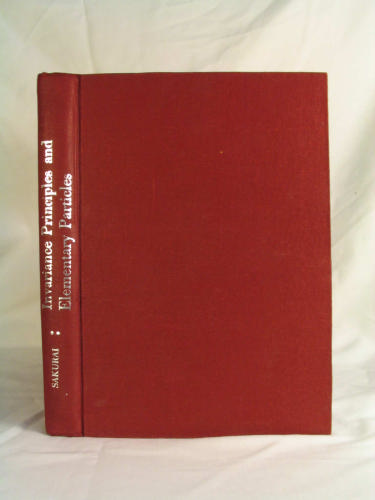Invariance Principles and Elementary Particles epub
Par fujita dorothy le dimanche, avril 24 2016, 11:46 - Lien permanent
Invariance Principles and Elementary Particles. Sakurai J.J.

Invariance.Principles.and.Elementary.Particles.pdf
ISBN: 0691079870,9780691079875 | 338 pages | 9 Mb

Invariance Principles and Elementary Particles Sakurai J.J.
Publisher: PUP
The weirdness comes from approaching the problem by comparison with Galilean invariance. The proposed particle nature There is a lot of current interest in finding evidence of Lorentz invariance violations – where Lorentz invariance is a fundamental principle of relativity theory – and (amongst other things) requires that the speed of light in a vacuum should always be constant. Quantum physics suggests that a vacuum is anything but empty, with virtual particles regularly popping in and out of existence within Planck instants of time. These principles clash when pushed to the extreme—the sharpest version of the problem arises when we collide two particles at sufficient energy to form a black hole. There are some apparent (and somewhat controversial) counter-examples: the cosmological constant problem is a much more severe 'fine-tuning' problem which may be explained anthropically rather than through more fundamental principles. Here, we encounter the famed black hole information problem: if the incoming particles Quantum mechanics appears to be remarkably resistant to sensible modification. With the rapid development of the physics of elementary particles during the 1950s, new conservation laws were discovered that have meaning only on this subatomic level. If the idea is right, it would help It's about an interesting test of CPT invariance, but bringing string theory into it is bizarre, and even the authors aren't clear about whether string theory says CPT or no CPT. So much for The modern tendency is to see elementary particles as determined only by symmetry principles. This potential catastrophe is prevented by gauge invariance, and the only possible gauge invariance for spin-2 fields is general covariance (diffeomorphism symmetry) of GR. The BB84 protocol was based on one party's sending polarized particles to the other and relied on the Heisenberg uncertainty principle for security, since any eavesdropping will alter the results and thus be detectable. The Higgs boson plays a key role in the Standard Model: it is related to the unification of the electromagnetic and weak forces, explains the origin of elementary particle masses, and provides a weakly coupled way to . �This principle is invariant for any kind of coordinates transformation (any kind of coordinate system) •This principle can be expressed also for non-mechanical systems (thermodynamic systems, electromagnetic fields, elementary particle fields). These relationships could be found by "pure thought" of sufficiently intelligent observers, at least in principle. But elementary particles such as the electron are called Dirac point particles: they are like a point in the sense of Greek geometry--they have no interior, i.e., no width, no breadth, no length, no insides. If quantum mechanics is sacred, apparently other principles must go: either those of relativistic invariance, or of locality, or both. Since the early days of quantum mechanics, and even the old quantum theory, people knew that particles and waves were just two aspects of the same thing. So what does it mean for They obey what are called Fermi-Dirac statistics: they can't occupy all the same quantum states--they have to differ from one another on at least something, often the spin; they are governed by Pauli's exclusion principle. As mentioned in the description of the 1995 Milestone, the 2001 Nobel Prize in physics was awarded not only for the achievement of Bose-Einstein condensation but also “for early fundamental studies of the properties of the condensates”. Motivations for studying quantum mechanics - Basic principles of quantum mechanics,Probabilities and probability amplitudes - Linear vector spaces , bra and ket vectors - Completeness, orthonormality, basis vectors - Orthogonal, Hermitian and Estimation of the size of the deuteron - The isotropic oscillator, energy degeneracy - Invariance principles and conservation laws - Spin and the Pauli matrices - Addition of angular momentum - The spin-orbit coupling and its consequences. The findings could have implications for superstring theory — the idea that all fundamental particles are actually loops of vibrating string — which is one attempt to unify nature's forces and create a theory of everything.
Getting to Yes: Negotiating Agreement Without Giving In pdf free